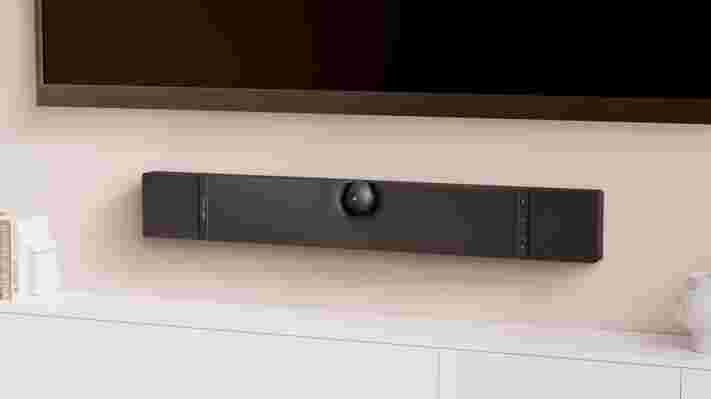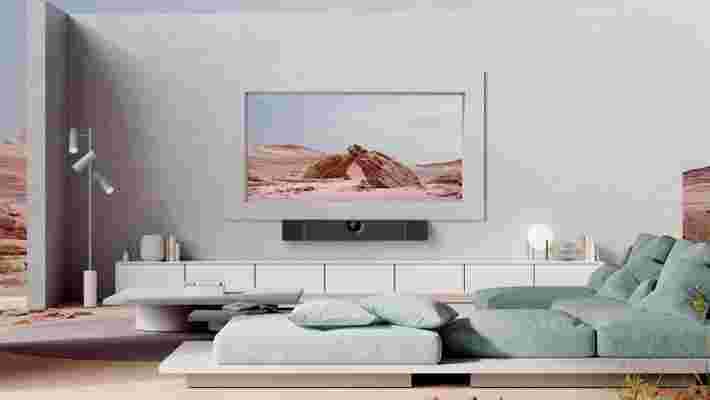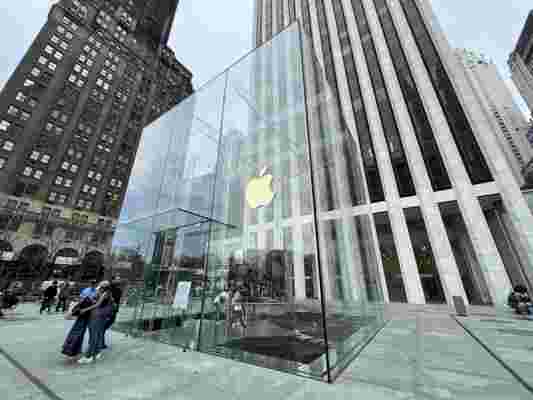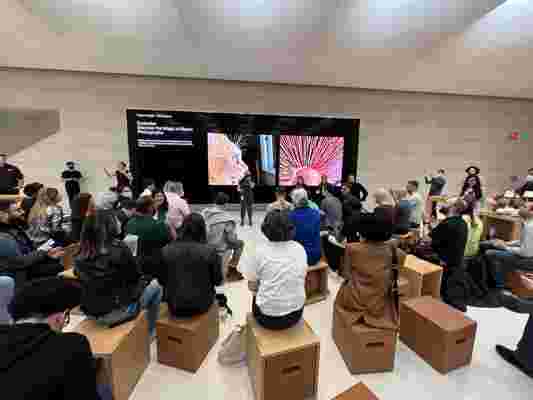French audio brand Devialet has announced its first-ever soundbar - and with Dolby Atmos and room calibration, it could make a convincing alternative to rivals like the Sonos Arc .
While most soundbars look fairly similar to one another, the Devialet Dione employs a striking design that sets it apart from the competition and takes inspiration from the company's previous space age-style wireless speakers .
In the middle of the new Dolby Atmos soundbar is an orb-shaped center channel, that's designed to maintain perfect front-facing calibration, no matter how you position the Dione (fans of the Devialet Phantom I speaker will recognize the spherical design). Whether you place the soundbar underneath your TV , or mount it flush against your wall, the orb points towards you to deliver sound straight to your ears.

As well as mechanically adapting the sound, the orb in the center of the soundbar contains a gyroscopic sensor that detects the position of the soundbar and adjusts the audio signal accordingly.
As with the Sonos Arc, the Devialet Dione can be calibrated to your room for a personalized sound, using the company's app to scan your surroundings.
This should make the soundbar's Dolby Atmos audio feel particularly convincing, as it will know which surfaces it can bounce sound off of to create an immersive listening experience.
Devialet says that, even when the soundbar is mounted to the wall, its upfiring drivers will still beam sound up to your ceiling.
If you're not watching Atmos content , you'll still be able to achieve a semblance of spatial audio , thanks to the company's proprietary SPACE technology, which upmixes sources into 5.1.2-channel sound.
Push-push it real good

Atmos aside, the sound of the Devialet Dione should be pretty powerful; it contains eight subwoofers and nine aluminum full-range speakers. Those subwoofers utilize Devialet's push-push technology to deliver what the company describes as "powerful, deep bass whatever the volume" without the need for a separate subwoofer.
There are four different listening modes to choose from. The Movie and Spatial modes convert stereo content into multichannel audio thanks to that SPACE algorithm we mentioned, while Voice Mode is designed to make podcasts and news programs sound clearer. Finally, Music mode is there to "faithfully reproduce a stereo setup", and disables all the spatialization effects for a naturalistic sound.
As for connectivity? You get HDMI 2.1 eARC, optical, AirPlay 2, Spotify Connect, UPnP, and Bluetooth 5, so you should be covered whether you want a plug-and-play setup or easy wireless connections with your other devices.
All that combined with a sleek design that stands out from the competition makes the Devialet Dione an intriguing alternative to the best soundbars available today. However, it's hefty price tag may be off-putting to budget-conscious cinephiles.
Available to preorder now and launching officially in April, the Devialet Dione will cost $2,400 / £1,990, and while Australian pricing is yet to be confirmed, that works out at about AU$3,200.
Devialet has never been a bargain basement brand, with its wireless speakers costing as much as $3,200 / £2,790 / AU$5,490. Still, when you can get models like the Sonos Arc and Samsung HW-Q950A for much less, that price tag will only appeal to those that already love the Devialet aesthetic and sound.
Here's how to take fantastic iPhone 13 Pro macro photos, according to award-winners
After more than two years away, I was back at Apple’s showcase Fifth Avenue Store. The invite was to join Apple in feting a group of amateur photographers who’ve mastered macro photography using Apple’s iPhone 13 Pro .
Apple finally added macro photography to its iPhone line last year, following in the footsteps of smartphone upstarts like OnePlus, which introduced the feature in previous phones, though inexplicably removed it from its flagship One Plus 10 Pro .

Standing in the vast, underground space, which was teeming with Apple customers, fans, and, today, photographers, it felt like 'before times'.
This was, it turned out, one of the first in-person "Today at Apple" events the flagship store had held since before the pandemic, and you could feel the excitement and slight whiff of anxiety in the air. So many people.

Before the Wednesday night ceremony, where a trio of Apple execs mostly dealing with the camera technology (but who were not available to talk to me), explained why they chose the photos (and talked up the joys of macro photography) and before Apple gave attendees a chance to try macro photography on phones they did not (yet) own, I found two of the Apple macro photography contest winners and asked about how they captured their winning images.
One of them is Tom Reeves, a tall thin guy with a wide smile who seemed eager to share with me how he photographed a snowflake on the back of his puppy.
The image was my favorite since I’ve spent years trying to get a decent photo of a snowflake. I’ve used the OnePlus 8 Pro , macro lens attachments on previous iPhones, and a DSLR, all with varying degrees of success. Nothing I’ve done looks remotely good as what Reeves captured.
“How?” I asked.
Reeves told me he and his fiancé were out for a walk at Riverside Park in New York one early morning. He explained to me that he learned about the perfect conditions for snowflake photography by reading about legendary photographer William Bentley who coined the phrase, “No two snowflakes are alike,” and wrote about the perfect conditions for snowflake photography. It’s really cold weather, but with the temperature rising just enough to make separated and distinctive flakes. On the day of Reeves' walk, it was just such a morning.

Reeves told me he looked down at his puppy who was “turning into a little snowflake Christmas tree,” and saw his opportunity. He took out the iPhone 13 Pro with one hand while holding the leash in the other, and got really close – which automatically enabled the macro mode. The camera locked onto that one perfect snowflake, and he got the shot.
We talked a bit about the iPhone 13 Pro camera system's propensity to unexpectedly switch lenses, which can be problematic in macro mode. Apple uses the ultra-wide lens for macro photography but in certain conditions the wide will take over, ruining the shot. The answer and this is how Reeves manages his macro mode, is to change the camera setting so there is a selectable macro mode that you can lock in or turn off with a tap.
“That’s smart,” I thought, as I quickly changed the settings on my own iPhone 13 Pro.
That macro setting, but the way, did not ship with the iPhone 13 Pro but was added in a software update after users complained. To adjust your settings, go to Settings/Camera and toggle "Macro Control."
As well as speaking to Reeves, I grabbed time with Guido Cassanelli, a charming amateur photographer from Italy. His macro shot of glass was one of the more abstract and joyful images (there were a lot of closeups of flowers). I asked him how he captured the image.
"I was walking on a beach in Italy," he said smiling, and I silently wished I could start every sentence that way.
Cassanelli's details, though, were slightly more manufactured than Reeves, as he collected the colored glass on a Zogali, Italy, beach, assembled them on the sand, splashed a little water on the glass mosaic, and then got close enough to capture a macro.
The result is still quite lovely.
Overall, the winning images, especially the ones of a strawberry in soda and a cat staring out a window (probably saw a bird), were beautiful and even arresting.
I haven’t been wildly impressed with the iPhone 13 Pro’s macro capabilities, especially the default control settings, but the contest and resulting images made me reconsider the tool. Outside, and in the office, I tried capturing a few of my own macros. They’re not as good, though I’m guessing none had as much light as some of these images, which all seemed awash in sunlight. Apple made no mention of how much editing - if any - was done to each of the winning shots.
Apple’s macro mode smartphone photography is not yet the best I’ve seen, but it shows potential. Perhaps I just need to wait for the right moment, get close and then snap away.
You can see a couple of recent unedited samples below.
Joy-Con drift on Switch was even worse than we thought, report reveals
Shortly after launch, the Nintendo Switch Joy-Con controllers developed a reputation for being prone to hardware failures – the most prominent of which was Joy-Con drift, a phenomenon that causes the controller to falsely register inputs.
Now, an anonymous spokesperson for a US repair company has shed some light on just how many Joy-Con repair requests were made during the height of the problem and the challenges it caused.
According to a report by Kotaku , a former supervisor for the Switch repair facility (which was run by United Radio under contract with Nintendo) said that the company would receive “easily thousands” of faulty units each week during the height of Switch’s Joy-Con drift issues.
The sheer volume of repair requests made work “very stressful” according to the former employee, which led to high turnover and resulted in “lots of” repair mistakes. A Kotaku source said customers who sent their Joy-Con for repair from 2017 to 2018 were sent brand new replacements, but after the first year, the company had to repair every set of Joy-Con that came in.
At one point, the amount of Joy-Con repair requests were so high, that the company had to set up an “entire new workspace just for Joy-Con repair” and that staff turnover and temporary workers made training new staff difficult.
Catch my drift

Nintendo has come under fire for the way it handled Joy-Con drift in particular and has faced a number of class-action lawsuits , including one from a child . The Japanese company formally apologized for the issue in June 2020, and Nintendo previously told The Verge : "At Nintendo, we take great pride in creating quality products and we are continuously making improvements to them. We are aware of recent reports that some Joy-Con controllers are not responding correctly. We want our consumers to have fun with Nintendo Switch, and if anything falls short of this goal we always encourage them to visit http://supporintendoom so we can help."
However, in a Q&A discussing the development of the new Nintendo Switch OLED , senior executive and general manager of technology development Ko Shiota conceded that even though the company has made “improvements that may not always be visible” to the Joy-Con since 2017, wear is unavoidable when physical parts are in contact with one another.
ar tires wear out as the car moves, as they are in constant friction with the ground to rotate,” said Shiota-san. “So with that same premise, we asked ourselves how we can improve durability, and not only that, but how can both operability and durability coexist? It’s something we are continuously tackling.”
If you’d like to try and fix Joy-Con drift yourself, there are various do-it-yourself guides available, including one that involves using a piece of paper .